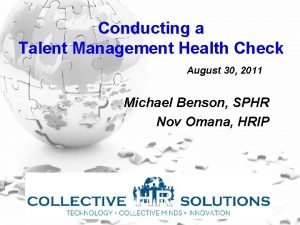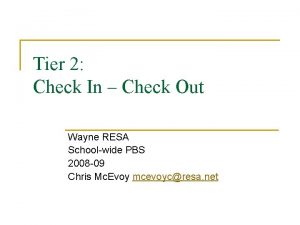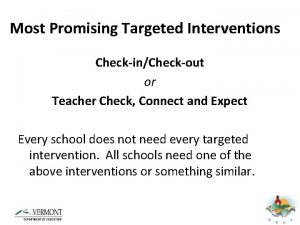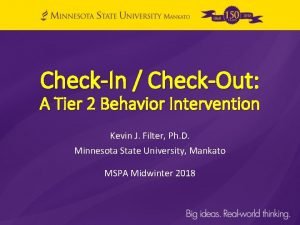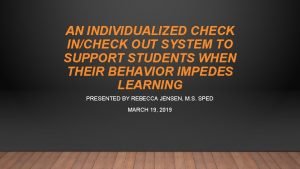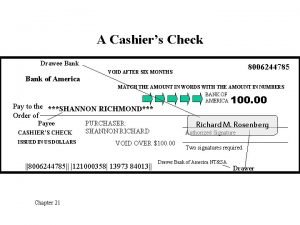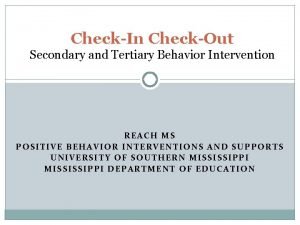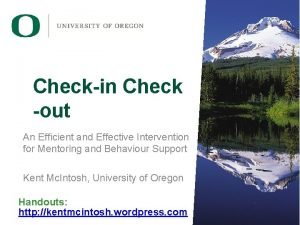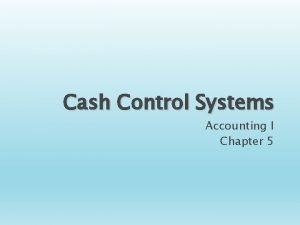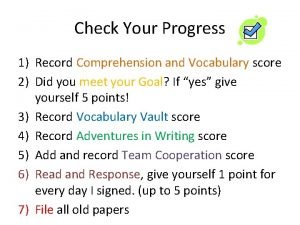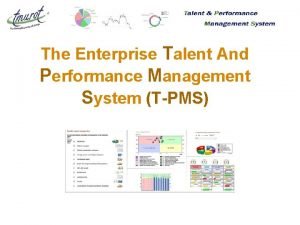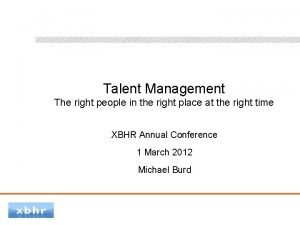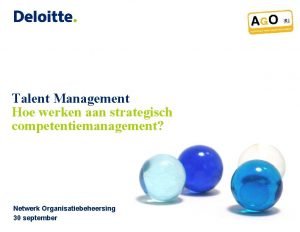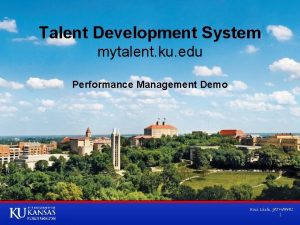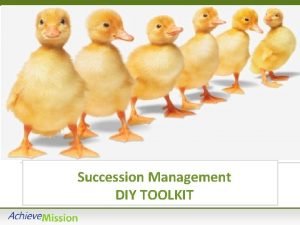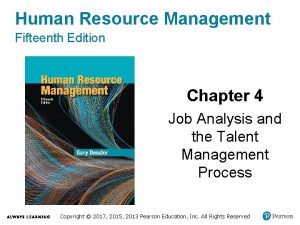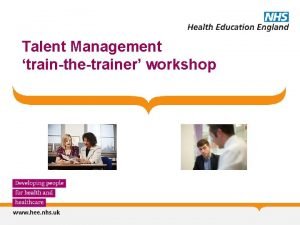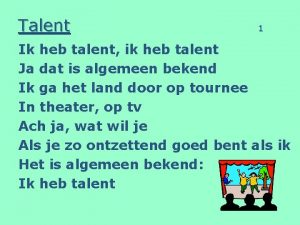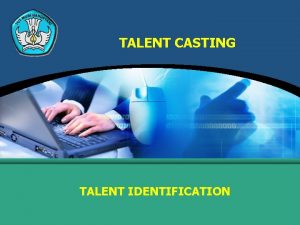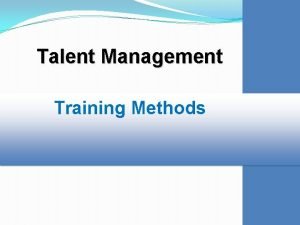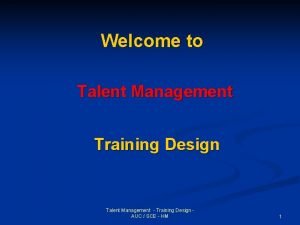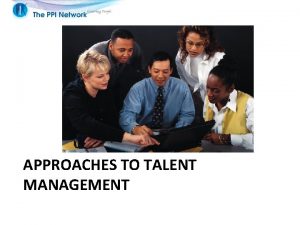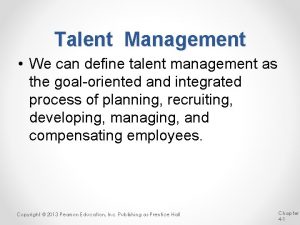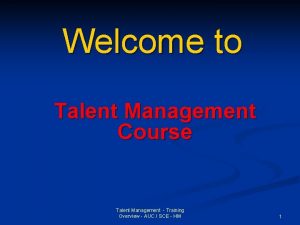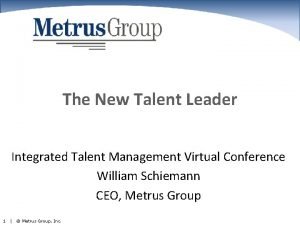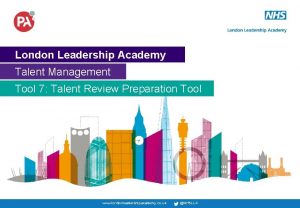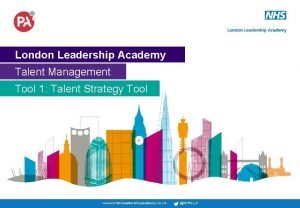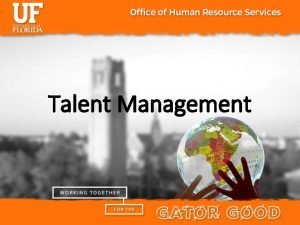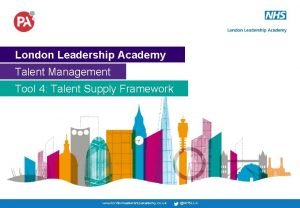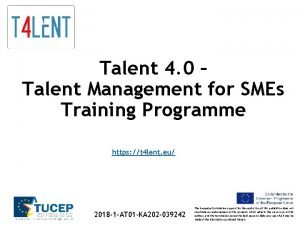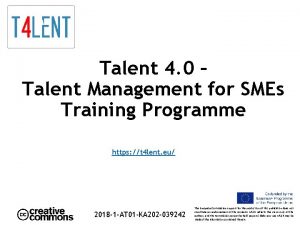Conducting a Talent Management Health Check August 30






















- Slides: 22

Conducting a Talent Management Health Check August 30, 2011 Michael Benson, SPHR Nov Omana, HRIP

Agenda • What we’re not going to talk about today • Goal of a Talent Management Health Check • Questions that drive Talent Management initiatives • Defining “Talent Management” – 10 domains • Health Check steps involved – What is the current evolutionary state of your business – Identify questions to explore/evaluate – Charting your responses – Adopting leading practices • Collective HR Solutions • Q and A

What we are not going to talk about today • We are not going to try and sell you on the value of taking a holistic view of talent management. • That there is evidence showing companies who focus on talent programs have higher financial performance. • That it is critical to know who your top performers are because they are 2 – 5 times more productive than average performers. • That the impact of “bad fit” Hires is 40% fail within the first 12 months. • That the cost of bringing new talent on board is significantly greater than nurturing and “growing” internal talent. • And, that the “water cooler” is no longer the water cooler.

Goal for a Talent Management Health Check A Talent Management Health Check involves a process of evaluating what leading Talent Management practices (across 10 domains) are being employed by you, against the importance of those practices to support your company’s goals. The result is an individualized road map of which Talent Management domains you should focus on to meet your goal objectives.

Are you asking these questions: • Where could we reduce costs associated with workforce management? • How well is the workforce management strategy and services aligned with our company, or department strategy? Is our workforce strategy aligned to successfully execute our long term operational strategy? • Does our workforce have the skills and capabilities needed to drive results today and five-ten years from now? • Do we have sufficient visibility into what skills our people have and where these skills exist through the Department so that we can deploy our workforce appropriately? • Are our workforce measures and metrics driving greater performance? • Are our employees able to find the experts and knowledge they need when they need it? • Is our leadership team able to manage the current operation while navigating the complexities of changing priorities? • Where could we do better regarding our workforce management? Where are there opportunities for improvement compared to leading practices?

Domains of Talent Management Domains Social Media & Collaboration Workforce Planning Succession Management Recruiting / Sourcing Competency Framework Leadership Development Performance Management Rewards Learning and Development Workforce Measurement Competency Framework Leadership Development Performance Management Learning and Recruiting/Sourcing Succession Workforce Rewards Management Planning Social Workforce Media Measurement &Development Collaboration Establish Competency Recognize and drive the right Adopt a “Talent Supply Chain” Ensure leadership development Organizational Processes and metrics technology that assess to All critical opportunities Pipeline Establish ofaa alearning succession compensation to ensure strategy Establish sourcing model (i. e. Framework strategy and behaviors and outcomes, with discipline key talent labor supply and training strategies include business connect impact, people program to rewards the should have that long gives term theassociated success right ofright the for the attract, recruit, select, on-board) supporting processes as a are appropriate learning opportunities and demand analysis and assessment of ability toand manage payback, experts, technology, information competencies and skills business right employee “pivotal” behaviors. roles based on where required competencies foundation. ID core, to address gaps inopen proficiency framework. Ensure sourcing staff development. performance, applications productivity, tofor drive knowledge cost “attached” that employees should being Compensation developed strategy to take on can more and skill needs positions. business/professional, and levels. Tied to required job strategies include match ofthen optimization, worker andjob EE be evaluated against. responsibility reinforce the and organizational grow. Includes their Look first productivity. to filladaptability internally, specific components. competencies/skills, positions to existing EE base, workforce profilesthat and effectiveness. ability toand capture ID capacity culture for future you desire. roles. external. Requires ability to and “see” assessment of required consultants, temps, offshore, and develop intellectual appropriate capital dashboards talent profiles across(blogs, the wiki’s, proficiency levels. Should be an outsourced that knowledge includealternatives. “trending” management). indicators. organization. on-going process, not an annual exercise.

Domains of Talent Management Domains Workforce Planning Succession Management Recruiting / Sourcing Competency Framework Leadership Development Performance Management Rewards Learning and Development Workforce Measurement Technology Solutions Change Management Social Media & Collaboration Technology Solutions

Integration Example Pivotal jobs have a defined set of competencies and skills associated with them, as well as desired levels of proficiencies to be “effective”. Competency, Workforce Planning Id job to fill Presumably with an individual who has competencies and skills required of the job. Recruiting/Sourcing Fill job Compensate, reward people in the job. Rewards Compensate/Reward To what degree does EE exhibit desired level of proficiencies of competencies and skills for the job. Performance Management Eval performance Is the employee ready for a new job/position? Leadership Development, Succession Planning Ready for job move/ promo Yes Assign new job No Dev Plan/Goals Learning Content / opps Pivotal jobs have a defined set of competencies and skills associated with them, as well as desired levels of proficiencies to be “effective”. Competency, Workforce Planning All learning content has associated competencies and skills that student should be proficient at when he successfully completes. Learning and Development, Collaboration Utilize metrics at each stage to assess effectiveness, efficiency of processes.

First … • Know what evolutionary “stage” your company is in: – Start up – Growth – Mature – Decline • If you are a larger firm, you may have lines of business in all of these stages. • Determine what your “focus” will be – entire company, or specific lines of business.

Metrics Collaboration Succession Leadership Performance Learning Rewards Recruiting Wrkf Planning Competencies Talent Management practices employed Decline Mature Growth Start Up

Analyze … Strongly disagree ----Low importance • The process involves asking questions about the evidence of Domain # Question 2 3 4 5 6 practices and the importance of them. 1 1 2 Performance Management 3 4 5 All employees have agreed personal business objectives and individual development plans in place We enter and review/approve performance goals using an online system We conduct interim reviews and adjust development goals/plans as appropriate We stay abreast of changes in Performance Management practices through membership or partnership with organizations providing thought leadership in the Performance Management area (e. g. APQC, HCI, etc. ) We identify performance metrics that are meaningful, appropriate, measurable and clearly defined X Importance X Evidence X Importance Evidence Importance 7 X Evidence Strongly agree ----High importance X X

Mapping existence of leading practices in the organization to the importance they have • Your answers are charted in a quadrant that reflects the gaps and what you should focus on. Y n n The Y axis reflects the degree to which a the practice is currently in place at Company. High Degree of Evidence Low Level of Importance The X axis reflects the level of to which the practice is important to the Company. “Low degree of Evidence” and “High level of Importance” are the opportunities for additional focus. Degree of Evidence n Practice Low Degree of Evidence Low Level of Importance High Degree of Evidence High Level of Importance Low Degree of Evidence High Level of Importance X

Hypothetical Company Example • • • Privately held Company in Growth position Exit strategy is for IPO Current company objectives – build a strong infrastructure and team for developing, selling, maintaining product Long term objectives – attract the best product developers and be the strongest innovator in the field First started in 2006 Growth every year (about 7%) to 350 employees Business plans show a growth to 600 in two years Funding is steady providing a base revenue for planning purposes

Analysis Average Importance 1 Competencies 1 6 2 Wrk Planning 2 4 3 Recruiting 6 7 4 Rewards 5 5 5 Lrng & Devel 2 5 6 Performance 3 4 7 Leadership 1 7 8 Succession 1 4 9 Collaboration 1 5 10 Metrics 2 5 Chart the results. . . Evidence Domain Average Evidence Importance Focus on these. . .

Next steps • Analyze people, process, and technology solutions you have in place for each domain focus area. • Develop a action plan and roadmap for addressing these issues. • Their level of importance will be evidenced by the amount of funding and effort you commit.

Some Leading Practices Domain Social Media and Collaboration People Process Technology Culture encourages knowledge sharing and responding to requests to promote an innovative and agile workforce. The organization actively promotes and is able to support the ability to connect people to people, processes and information either for technical, process or cultural reasons. Technology-enabled social networking and collaboration environments exist. People communicate and collaborate across traditional boundaries such as organizational, geographical and hierarchical. People feel comfortable seeking out others. There are clearly articulated collaboration guidelines and trust of all employees is a core value. Employees have the ability to create and update profiles, create discussion blogs, wikis, etc. People freely share their expertise and knowledge. There is an attitude of openness and transparency and walled gardens are only established when there is a fundamental business need. Employee profiles include work and non-work experience and competencies, pre and post employment experiences, as well as personal information about who they are and what is important to them, their collegial connections, and links to their work products, ideas and opinions (resumes, blogs, books, thesis, articles, etc). There is a capability to analyze large amounts of text data to be included in the employee profiles. The organization “mines” this data regularly and implements changes that encourage the continued engagement of employees. People can find other people, expertise, and information easily and quickly and leverage it, apply, reuse good ideas, and innovate to meet organizational goals and priorities. Organizations are innovative. They leverage good ideas from employees, business partners, suppliers, customers, the world. The organization leverages social media and collaboration tools in their training and development activities.

Collective HR Solutions IS: • Specialized group of highly talented and experienced HR professionals…. . • Partnerships with a perspective towards innovative solutions…. . • Leading edge technology to meet your business needs… • Solving today’s problems with use of innovation and technology to achieve your business goals of tomorrow…. Innovative Technology Systems Integration Program Management Collective Knowledge Change Management Organizational Design Process Design Talent Management

Collective HR HCM Consulting Solutions CHRS’s HCM Consulting practice focuses on meeting the needs of dual Human Resource agendas: - HR Transformation - systems-enabled transformation that maximizes efficiencies and drives down costs of HR service delivery. - Talent Management - programs and technologies that enhance your workforce's ability to drive revenue and growth.

Collective HR Virtual Solutions Virtual World Solutions for Real World Challenges.

Collective HR Vendor Marketing Services We provide services to the HR Technology Vendor community to position your products and services to meet the demands of this growth market. Collective HR Solutions’ Experience • Extensive knowledge of Human Resources and the buying drivers • Deep understanding of the vendor market and trends • Experience in the selection and implementation of vendor products • Significant network of expertise Our Services • Conducting market research • Facilitate focus groups/requirements gathering of HR buyers • Assistance in Product Management strategy • Development of material for presentations and articles • Presentations customers or User Groups on HR Technology trends • Presentations to internal staff on HCM trends – knowledge transfer • Marketing assistance in branding and messaging • Developing and assessing partnerships


Collective HR Solutions, LLC 951 -2 Old County Rd. , #207 Belmont, California 94002 650. 341. 5067 (direct) 650. 740. 6558 (cell – Nov Omana) 925. 588. 6973 (cell – Mike Benson) 650. 403. 0777 (fax) Info@collectivehrsolutions. com
 Health talent management
Health talent management Behavior check in check out sheet
Behavior check in check out sheet Check in check out forms
Check in check out forms Check in check out behavior intervention
Check in check out behavior intervention Check in check out system for students
Check in check out system for students Where is the check number on a cashier's check
Where is the check number on a cashier's check Advantages and disadvantages of boundary fill algorithm
Advantages and disadvantages of boundary fill algorithm Check in check out behavior intervention
Check in check out behavior intervention Check in and check out intervention
Check in and check out intervention 1.7.6 - quick check: frost quick check
1.7.6 - quick check: frost quick check How to sign a check over
How to sign a check over Check your progress 1
Check your progress 1 Public service talent pool
Public service talent pool Enterprise performance management
Enterprise performance management Talent management wheel
Talent management wheel Competentiemanagement tool
Competentiemanagement tool Mytalent cms
Mytalent cms Talent review chart
Talent review chart Sap erp hcm performance management
Sap erp hcm performance management The pool talent management
The pool talent management Talent management scorecard
Talent management scorecard Chapter 4 job analysis and the talent management process
Chapter 4 job analysis and the talent management process What do we mean by being talented
What do we mean by being talented
